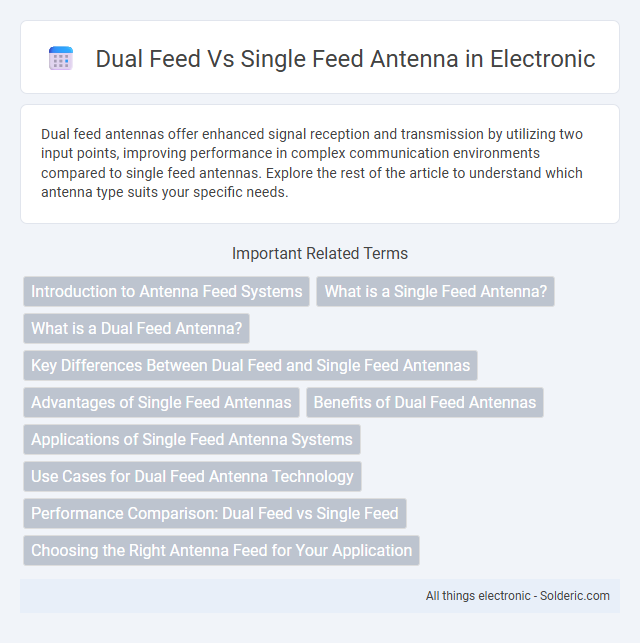Dual feed antennas offer enhanced signal reception and transmission by utilizing two input points, improving performance in complex communication environments compared to single feed antennas. Explore the rest of the article to understand which antenna type suits your specific needs.
Comparison Table
| Feature | Dual Feed Antenna | Single Feed Antenna |
|---|---|---|
| Feed Points | Two feed points for signal input | One feed point for signal input |
| Polarization | Supports dual polarization (horizontal & vertical) | Supports single polarization |
| Bandwidth | Typically wider bandwidth | Narrower bandwidth compared to dual feed |
| Complexity | More complex design and installation | Simple design and easy installation |
| Cost | Generally higher cost | Lower cost |
| Performance | Better isolation and diversity performance | Limited isolation; less diversity capability |
| Use Cases | Ideal for MIMO, LTE, and advanced wireless systems | Suitable for basic wireless applications |
Introduction to Antenna Feed Systems
Antenna feed systems are crucial for delivering radio frequency signals between the transmitter or receiver and the antenna radiator. Single feed antennas utilize one transmission line, simplifying design and reducing cost but may limit polarization and pattern control. Dual feed antennas employ two separate feeds, enabling improved polarization diversity, beam steering, and enhanced performance in complex communication environments.
What is a Single Feed Antenna?
A single feed antenna utilizes one feed point to transmit or receive radio frequency signals, simplifying its design and installation. This type of antenna typically offers a straightforward radiation pattern and impedance matching, making it ideal for applications where simplicity and cost-effectiveness are priorities. Single feed antennas are commonly used in Wi-Fi routers, television antennas, and basic communication systems due to their reliable performance and ease of integration.
What is a Dual Feed Antenna?
A dual feed antenna features two separate feed points that allow simultaneous or independent signal transmission and reception, enhancing versatility and performance in different frequency bands or polarizations. This design improves signal quality and reduces interference by enabling better impedance matching and polarization diversity compared to single feed antennas. Commonly used in applications requiring multi-band operation or advanced signal processing, dual feed antennas provide greater flexibility for modern communication systems.
Key Differences Between Dual Feed and Single Feed Antennas
Dual feed antennas use two separate input signals to improve signal quality and provide better control over polarization and radiation patterns, while single feed antennas employ a single input for simpler design and operation. Dual feed systems are ideal for applications requiring enhanced bandwidth and signal diversity, whereas single feed antennas are more cost-effective and easier to install for basic communication needs. Your choice depends on the required performance level, complexity, and budget constraints.
Advantages of Single Feed Antennas
Single feed antennas offer simpler design and easier installation compared to dual feed antennas, reducing overall system complexity and cost. Their efficiency is higher in applications where signal polarization is fixed, ensuring optimal performance without the need for additional tuning. You benefit from improved reliability and lower maintenance requirements due to fewer components and connections.
Benefits of Dual Feed Antennas
Dual feed antennas offer improved signal reception by enabling diversity reception, reducing multipath interference and fading effects. They provide enhanced polarization options, allowing for better matching with different signal polarizations and increasing overall signal quality. This leads to higher data throughput and more reliable communication in varying environmental conditions compared to single feed antennas.
Applications of Single Feed Antenna Systems
Single feed antenna systems are widely used in applications requiring simplicity and cost-effectiveness, such as mobile communication devices, Wi-Fi routers, and broadcast television antennas. These antennas excel in environments where limited space and low power consumption are critical, providing reliable performance for point-to-point communication and basic signal reception. Their straightforward design minimizes complexity, making them ideal for consumer electronics and portable wireless systems.
Use Cases for Dual Feed Antenna Technology
Dual feed antenna technology is ideal for applications requiring polarization diversity or simultaneous multi-band operation, such as in satellite communication and MIMO wireless systems. It enhances signal quality by reducing multipath fading and improving data throughput in complex environments. These antennas are commonly used in advanced radar systems and broadband wireless networks where robust and flexible signal reception is critical.
Performance Comparison: Dual Feed vs Single Feed
Dual feed antennas provide enhanced performance by enabling better polarization diversity and improved signal quality compared to single feed antennas, which often suffer from limited bandwidth and lower gain. Your communication system can benefit from dual feed designs as they reduce multipath interference and increase data throughput, especially in complex environments. Single feed antennas are simpler and more cost-effective but typically offer less flexibility and weaker overall signal stability.
Choosing the Right Antenna Feed for Your Application
Dual feed antennas offer enhanced signal reception and polarization diversity, making them ideal for applications requiring improved signal reliability and reduced multipath interference. Single feed antennas provide simplicity and cost-effectiveness, suitable for basic communication systems with less complex signal environments. Selecting the right antenna feed depends on factors like application requirements, environmental conditions, and budget constraints to ensure optimal performance and efficiency.
dual feed vs single feed antenna Infographic

 solderic.com
solderic.com